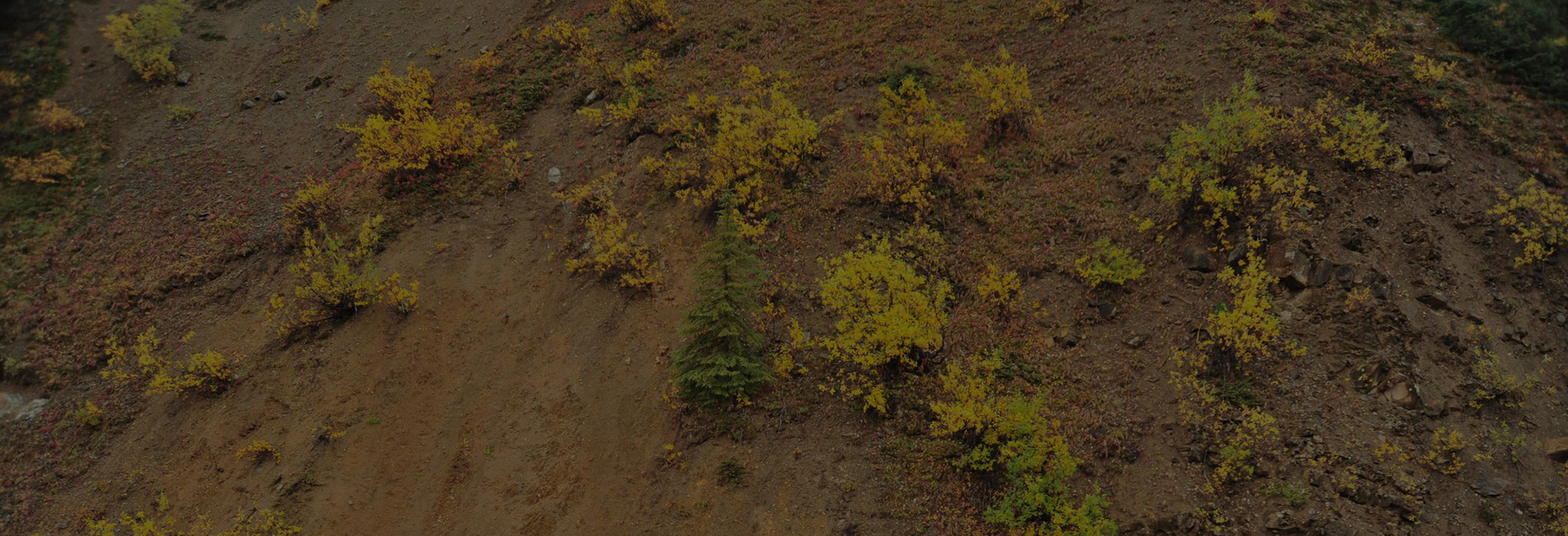- Hole V-23-049 returned 539.4 m averaging 1.20 g/t Au from surface (entire length in mineralization), including 2.41 g/t Au over 151.5 m, confirming robust continuity and grade well below and east of mineralization in V-22-007
- Hole V-23-050 returned 423.3 m averaging 1.08 g/t Au from surface, including 1.45 g/t Au over 252.0 m along northeastern edge of system, demonstrating strong near-surface mineralization that remains open
- Drilling ongoing at Valley, with assays still pending for more than half of 2023 drilling to date (12,428+ m remain, from 31 holes across 5 targets).
Vancouver, B.C., October 5, 2023: SNOWLINE GOLD CORP (TSX-V: SGD) (OTC: SNWGF) (the “Company” or “Snowline”) is pleased to announce additional analytical results from its ongoing drill program at the Valley target on its Rogue Project in Canada’s Yukon Territory. All four holes, drilled into various parts of the Valley system, returned continuously mineralized intervals ranging from 82.5 (average 1.52 g/t Au) to 539.4 m (average 1.20 g/t Au) in downhole length. Initial drill results from various other targets and projects encountered anomalous gold mineralization. Analytical results for an additional 19 holes (7,862+ m) at Valley and 12 additional holes (4,397 m) on other targets are pending, with drilling ongoing.
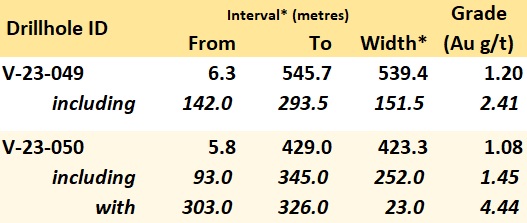
Table 1 –Highlight summary of Snowline’s latest assay results. *Interval widths reported; true widths of the system are not yet known.
“The exceptional nature of our Rogue Project’s Valley target is highlighted by the observation that holes such as V-23-049 and V-23-050, with average grades of >1 g/t Au from surface over hundreds of meters and >2 g/t Au over broad downhole distances, are proving to be commonplace and very consistent across a large geographical footprint,” said Scott Berdahl, CEO & Director of Snowline. “Notably, V-23-050 returned such intervals from what was previously considered to be the northeastern edge of Valley’s main near-surface mineralized zone, thus adding significant tonnage of known mineralized rock and demonstrating the open nature of the system in this direction. Even holes such as V-23-051, drilled at the southwestern edge of the Valley intrusion and into the surrounding hornfels, demonstrate a strong consistency of mineralization, with a result—again from surface—noteworthy in its own right. With our field program still active and the majority of our drill and surface results from 2023 still forthcoming, we look forward to rapid advancement of our target areas in the weeks and months ahead.”
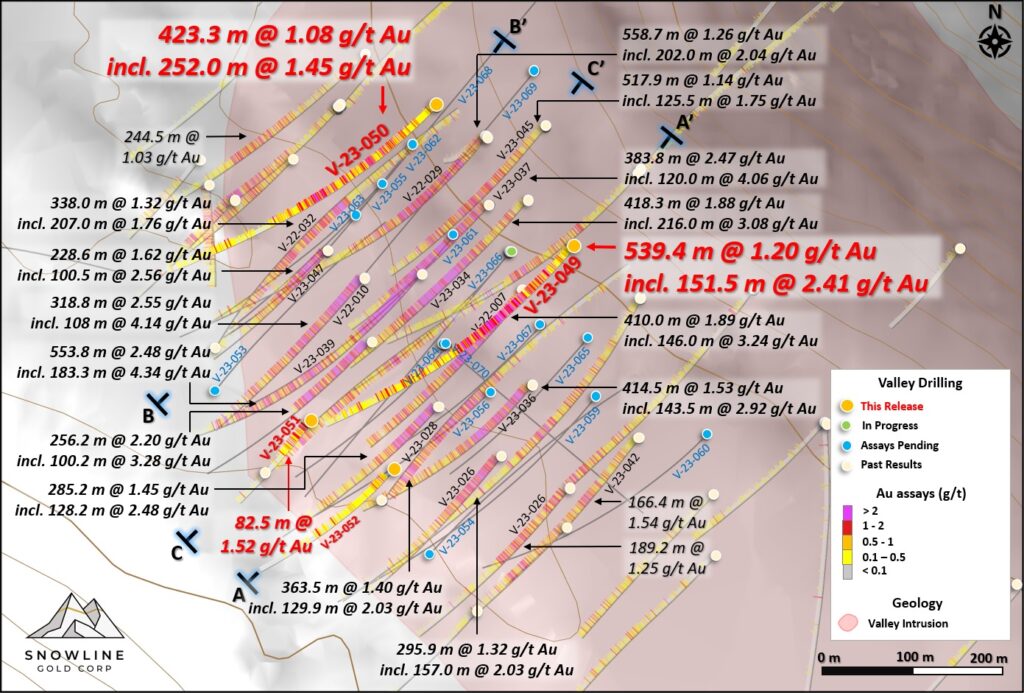
Figure 1 – Plan view of the Rogue Project’s Valley target showing analytical results from previous and current drilling, along with approximate traces of current holes. Current results expand the already wide distribution of unusually high grades for a reduced intrusion-related gold system at Valley, with mineralized intervals beginning at or near surface. The system remains open to the northeast and at depth.
HOLE V-23-049
Hole V-23-049 is collared within the Valley intrusion as a 71 m step back along section and perpendicular to the dominant trend of mineralization from V-22-007 (410.0 m @ 1.89 g/t Au from surface including 146.0 m @ 3.24 g/t Au, see Snowline news release dated November 15, 2022). The hole is collared in coarse-grained granodiorite and crosses several small (meter-scale) porphyritic dikes before encountering a larger porphyritic body from roughly 365-420 m downhole depth. The hole ends in coarse-grained granodiorite with low quartz vein densities and generally low grades.
The mineralized interval in V-23-049 spans the entire hole, averaging 1.20 g/t Au over 539.4 m downhole from bedrock surface at 6.3 m, including a 151.5 m downhole run from 142.0 m depth averaging 2.41 g/t Au, with a 10.5 m hotspot of 4.67 g/t Au from 201.5 m downhole. As with previous holes at Valley, mineralization is remarkably consistent. Capping assays at 10 g/t Au results in an average grade of 1.16 g/t Au, only a 3.1% reduction in overall grade (Table 2).
The hole shows a robust continuity of grade extending northeast of and below V-22-007. The drill trace cuts roughly halfway between those of V-22-007 and V-22-015 (442.0 m @ 0.65 g/t Au including 170.0 m @ 1.18 g/t Au, see Snowline news release dated December 22, 2022), and yet gold grades are higher than would be expected from a linear gradient between the two holes, demonstrating a larger volume of well-mineralized rock.
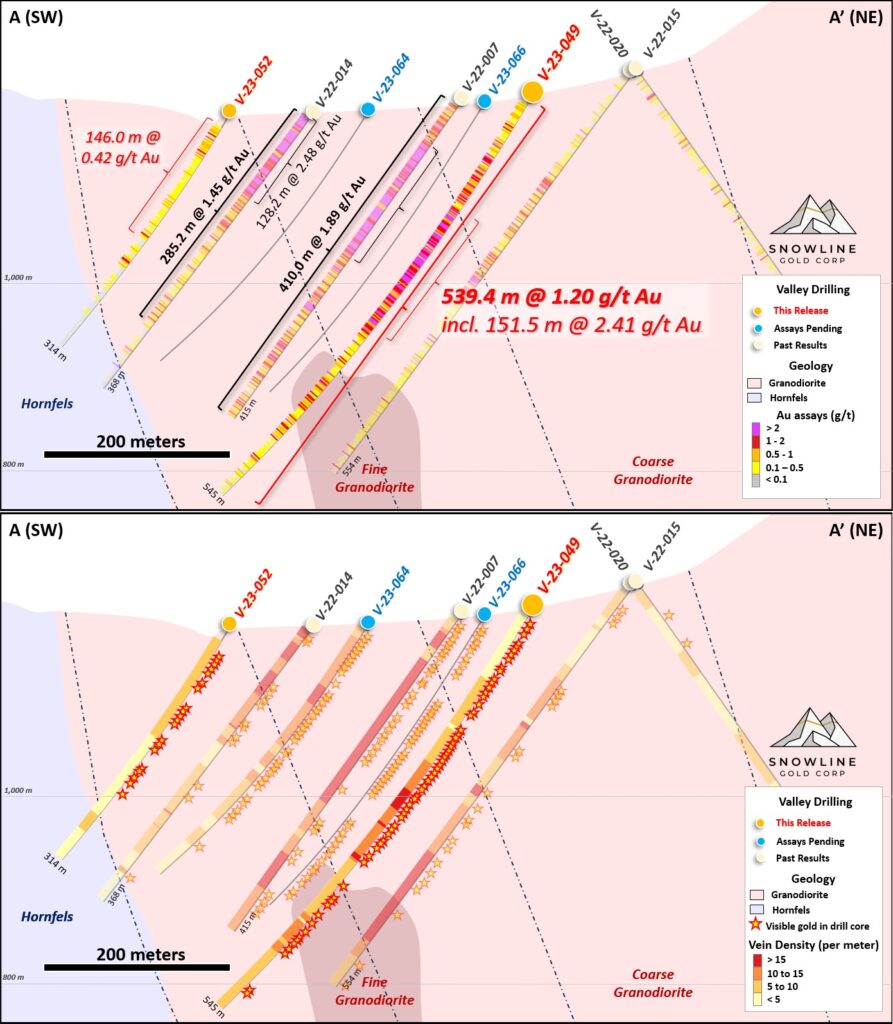
Figure 2 – Cross-section A, showing V-23-049 and V-23-052 in the context of surrounding holes and a simplified geological model. Top: Analytical results received to date and still pending (thin black lines with blue collars). Bottom: Vein densities alongside instances of trace visible gold observed during logging. V-23-049 demonstrates that strong mineralization seen in V-22-007 continues to depth well below that hole and to the east towards V-22-015.
HOLE V-23-050
Hole V-23-050 is collared within the Valley intrusion as a 66 m step-out along strike to the northwest of V-22-029 (558.7 m @ 1.26 g/t Au including 202.0 m @ 2.04 g/t Au, see Snowline news release dated February 24, 2023) and V-22-033 (313.0 m @ 0.86 g/t Au including 121.9 m @ 1.33 g/t Au, see Snowline news release dated December 22, 2022). The hole is entirely within coarse-grained granodiorite, apart from a porphyritic body intersected from roughly 340-408 m downhole.
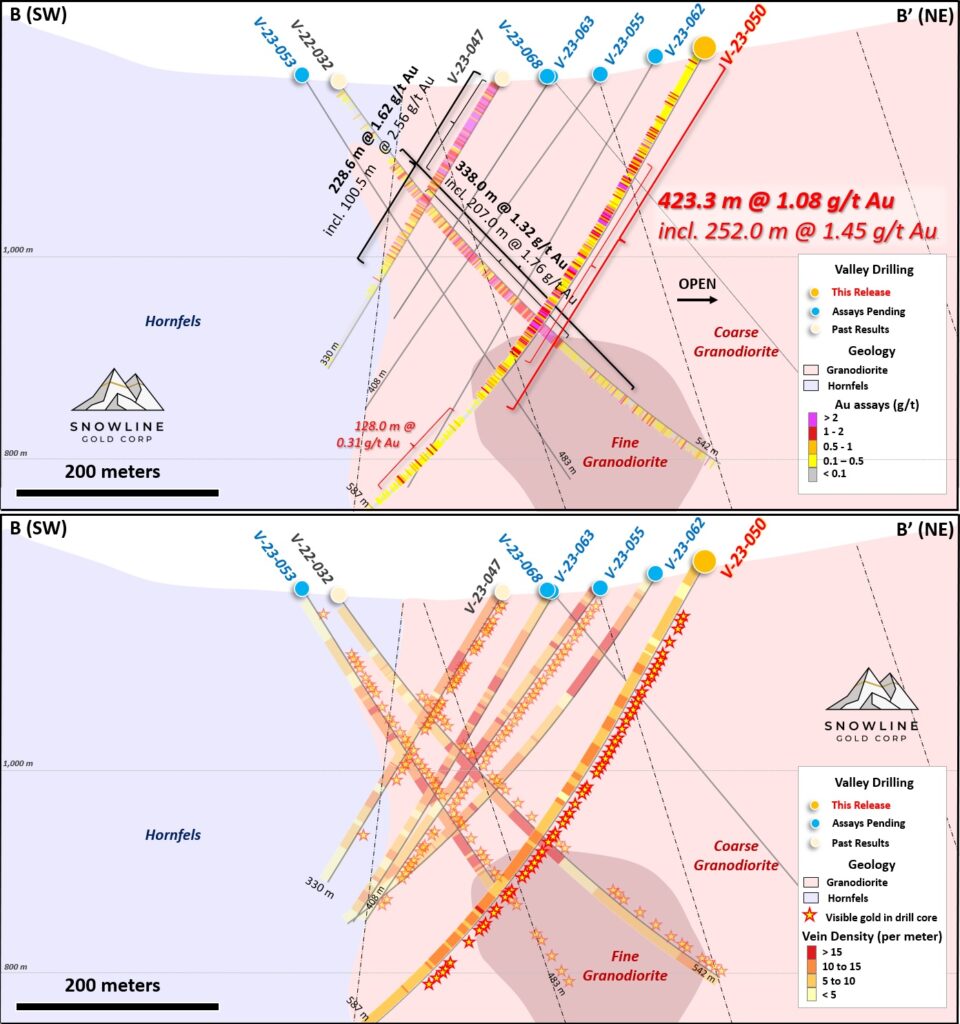
Figure 3 – Cross-section B, showing V-23-050 in the context of surrounding holes and a simplified geological model. Top: Analytical results received to date and still pending (thin black lines with blue collars). Bottom: Vein densities alongside instances of trace visible gold observed during logging. V-23-050 demonstrates strong, consistent mineralization at the northeastern margin of the main Valley zone that remains open. Note that due to hole deviation, the bottom of the hole is located behind the section (see Figure 1 for plan view).
The hole is mineralized from bedrock surface at 5.8 m depth through 423.3 m downhole, averaging 1.08 g/t Au. A higher-grade zone of 1.45 g/t Au over 252.0 m downhole from 93.0 m, including 4.44 g/t Au over 23.0 m from 303.0 m, demonstrates the strength of mineralization on the still open northeastern boundary of the system as it has been tested to date. Additional intervals of lower grade mineralization continue at depth within the hole.
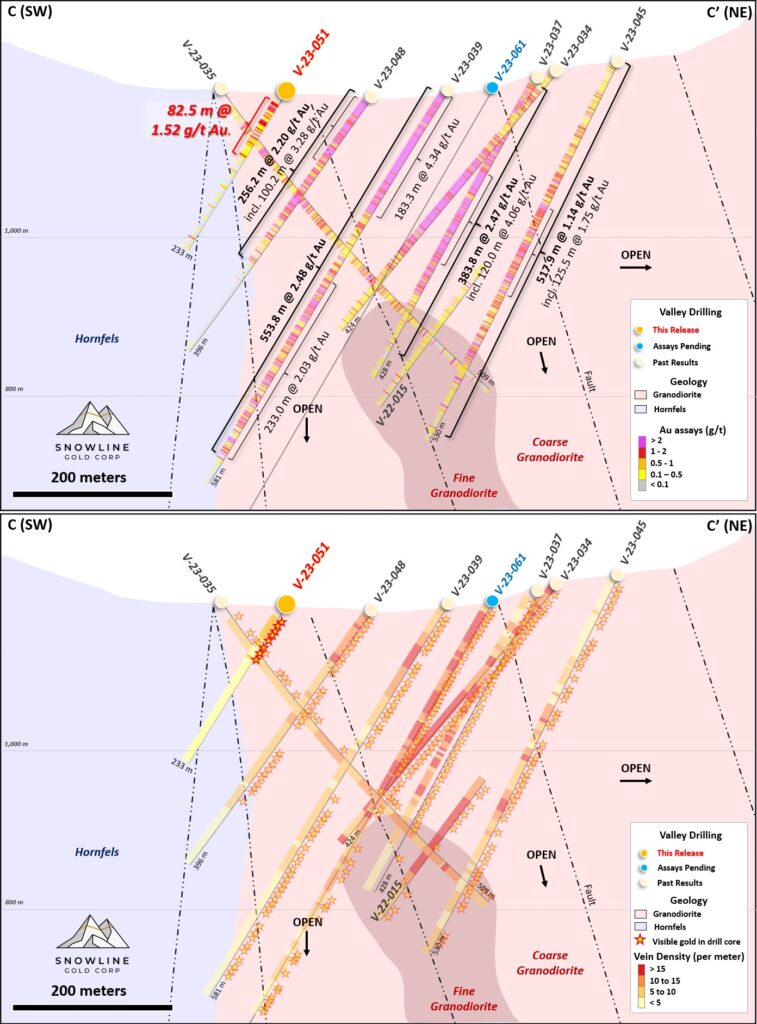
Figure 4 – Cross-section C, showing V-23-051 in the context of surrounding holes and a simplified geological model. Top: Analytical results received to date and still pending (thin black lines with blue collars). Bottom: Vein densities alongside instances of trace visible gold observed during logging.
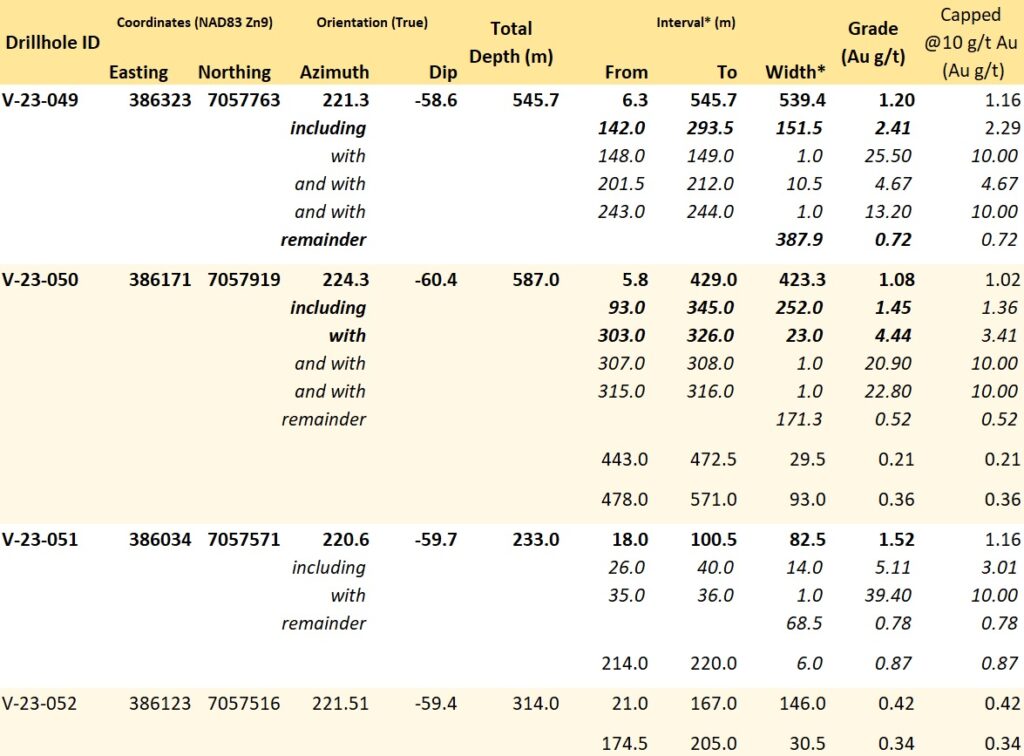
Table 2 – Summary of significant mineralization returned from current holes at Valley. The consistency of strong mineralization on the target is reinforced by the capped values in the rightmost column, wherein any assay result >10 g/t Au is replaced by 10.0 g/t Au to calculate the average interval grades. The high results demonstrate uniform gold mineralization that is not “smeared” across a given interval by isolated high-grade samples. *Interval widths reported; true widths of the system are not yet known, with different vein generations, orientations, and grade distributions present within various intervals through the bulk tonnage gold target at Valley.
EXPLORATION UPDATES
Valley Target Drilling, Rogue Project
The expanded 2023 drill program at the Rogue Project’s Valley discovery is ongoing. To date, >15,000 m has been drilled on the Valley target in 2023, with 36 holes completed and an additional larger diameter (85 mm PQ, versus 51 mm NQ2 used elsewhere) drill hole in progress for advanced metallurgical and rock property testing. A majority of drill results for the 2023 drill program at Valley are still to come, with results pending for 19 holes (8,031+ m).
Satellite Target Drilling, Rogue Project
At Reid, a single hole Phase I program intersected a poly-phase intrusive system, with a coarse-grained granodiorite phase, and a fine-grained porphyritic phase occurring as dikes outside of the main intrusion. Moderate to low vein densities yielded a mineralized downhole interval of 174.5 m averaging 0.27 g/t Au, from 303.5 m.
Phase II drilling at Gracie encountered sedimentary rocks with varying degrees of hornfels alteration, indicating proximity to an intrusion, and low-density sheeted quartz veins bearing rare instances of trace visible gold. Assays for G-23-006, which was aborted due to pad stability issues short of reaching its target, returned localized intervals of anomalous gold mineralization (Table 3). Analytical results for an additional 3 holes from Gracie, and a single hole Phase I program at Cujo are pending.
Cliff Project Drilling
Analytical results have been received for the first three drill holes of a 5-hole Phase I program at the Cliff Project. Gold bearing quartz veins were encountered in all three holes, with localized results of up to 6.64 g/t Au over 1.9 m drilled width (true width unknown). A summary of drill highlights at Cliff is found in Table 3.
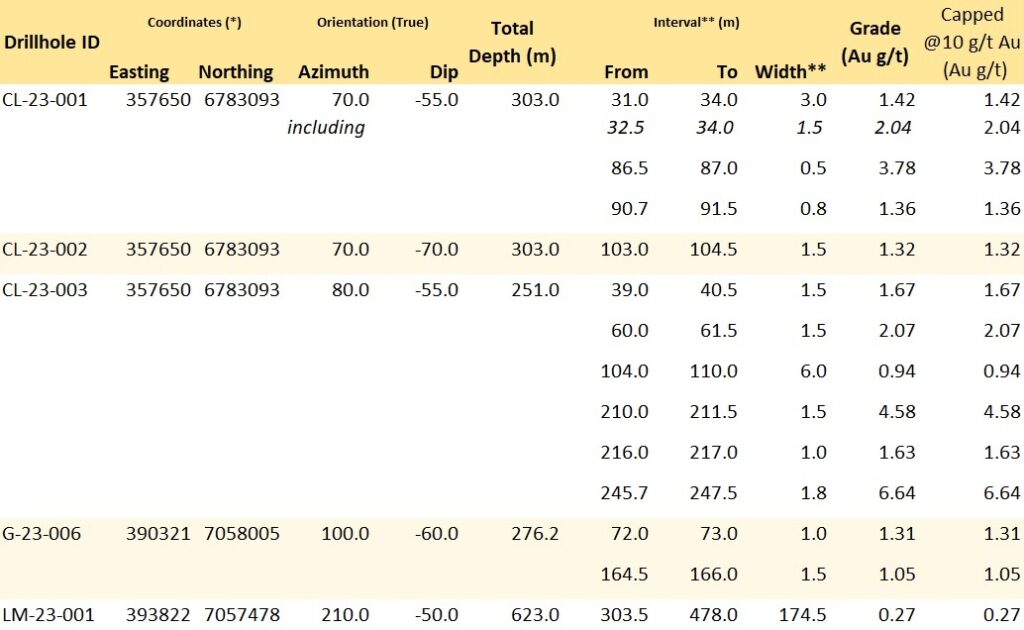
Table 3 – Summary of mineralization returned from current holes on satellite targets and projects. “CL-23-xyz” holes were drilled on the Cliff Project, whereas “G-23-xyz”and “LM-23-xyz” holes were drilled on the Gracie and Reid targets respectively, both on the Rogue Project. Various lesser intervals are present but not listed. Coordinates are presented in NAD83 Zone 8 for the Cliff target (CL-23-001 through CL-23-003) and in NAD83 Zone 9 for the Gracie and Reid targets. **Interval widths reported; true widths of the systems are not yet known.
QA/QC
On receipt from the drill site, Valley, Gracie and Reid’s NQ2-sized drill core was systematically logged for geological attributes, photographed and sampled at Snowline’s 2023 field camp. Sample lengths as small as 0.5 m were used to isolate features of interest, but most samples within moderate to strong mineralization were 1.0 m in length; otherwise, a default 1.5 m downhole sample length was used. Core was cut in half lengthwise along a pre-determined line, with one half (same half, consistently, dictated by orientation line where present or by dominant vein orientation where absent) collected for analysis and one half stored as a record. Field duplicates were collected at regular intervals as ¼ core samples by splitting the ½ core sent for sampling, leaving a consistent record of half core material from duplicate and non-duplicate samples alike. Standard reference materials and blanks were inserted by Snowline personnel at regular intervals into the sample stream. Bagged samples were sealed with security tags to ensure integrity during transport. They were delivered by expeditor to Bureau Veritas’ preparatory facility in Whitehorse, Yukon. Sample preparation was completed in Whitehorse, with analyses completed in Vancouver.
Similar procedures were employed on the Cliff Project, though drill core was transported to Whitehorse in advance of detailed logging and sampling.
Bureau Veritas is accredited to ISO/IEC 17025 and ISO9001 for quality management. Samples were crushed by BV to >85% passing below 2 mm and split using a riffle splitter. 250 g splits were pulverized to >85% passing below 75 microns. A four-acid digest with an inductively coupled plasma mass spectroscopy (ICP-MS) finish was used for 59-element analysis on 0.25 g sample pulps (BV code: MA250). All samples were analysed for gold content by fire assay with an atomic absorption spectroscopy (AAS) finish on 30 g samples (BV code: FA430). Any sample returning >10 g/t Au was reanalysed by fire assay with a gravimetric finish on a 30 g sample (BV code: FA530).
For the purposes of this release, mineralized intervals are defined as runs of mineralization with no break >5.0 m assaying <0.1 g/t Au, or continuous subsections thereof.
ABOUT ROGUE
The Valley target on Snowline’s flagship Rogue Project is a newly discovered, bulk tonnage style, reduced intrusion-related gold system (RIRGS), with geological similarities to multi-million-ounce deposits currently in production such as Kinross’s Fort Knox Mine in Alaska and Victoria Gold’s Eagle Mine in the Yukon. Early drill results demonstrate unusually high gold grades for such a system, present near surface across drill intersections of hundreds of metres. Gold is associated with bismuthinite and telluride minerals hosted in sheeted quartz vein arrays within and along the margins of a one-kilometer-scale, mid-Cretaceous aged Mayo-suite intrusion. Valley is an early-stage exploration project without a resource estimate, and while initial results are encouraging, the presence or absence of an economically viable orebody cannot be determined until additional work is completed.
The Rogue Project area hosts multiple intrusions similar to Valley along with widespread gold anomalism in stream sediment, soil and rock samples. Elsewhere, RIRGS deposits are known to occur in clusters. The Rogue Project is thus considered by the Company to have district-scale potential for additional reduced intrusion-related gold systems.
ABOUT SNOWLINE GOLD CORP.
Snowline Gold Corp. is a Yukon Territory focused gold exploration company with an eight-project portfolio covering >333,000 ha. The Company is exploring its flagship >94,000 ha Rogue gold project in the highly prospective yet underexplored Selwyn Basin. Snowline’s project portfolio sits within the prolific Tintina Gold Province, host to multiple million-ounce-plus gold mines and deposits including Kinross’s Fort Knox Mine, Newmont’s Coffee deposit, and Victoria Gold’s Eagle Mine. The Company’s first-mover land position and extensive database provide a unique opportunity for investors to be part of multiple discoveries and the creation of a new gold district.
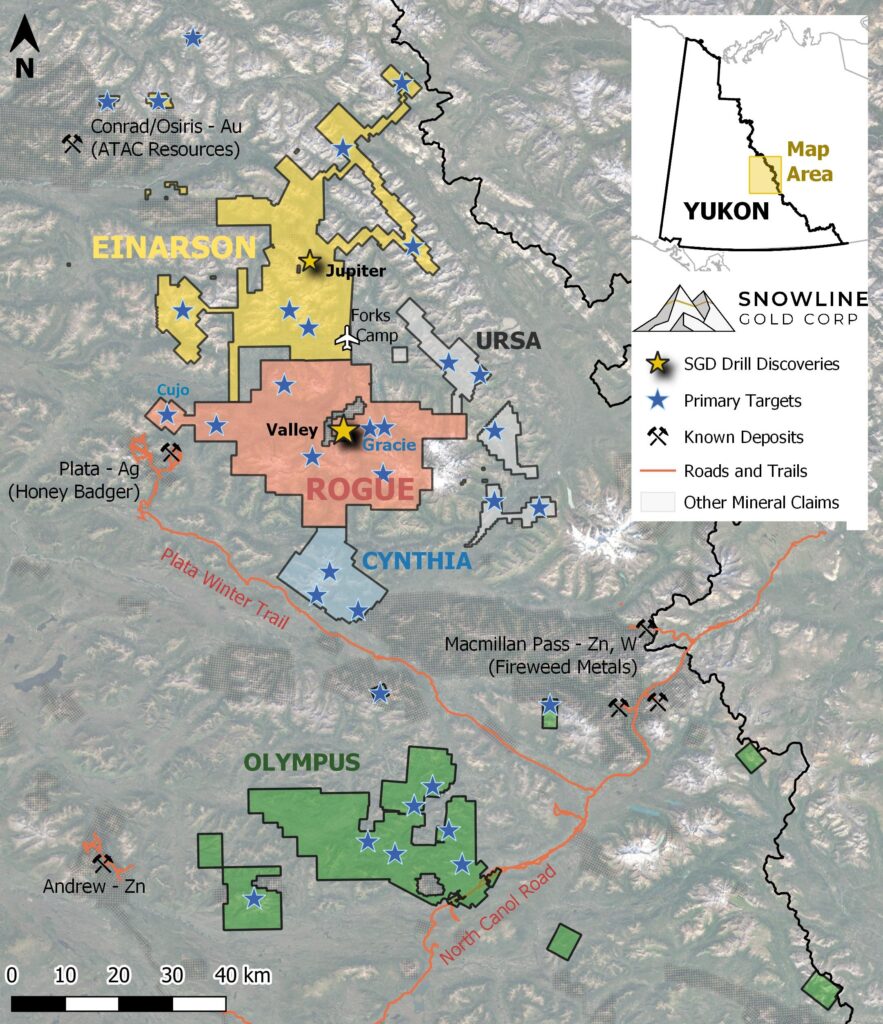
Figure 5 – Project location map for Snowline Gold’s eastern Selwyn Basin properties: Rogue, Einarson, Ursa, Cynthia and Olympus. The current work program at Rogue is based out of the Company’s Forks Camp.
QUALIFIED PERSON
Information in this release has been prepared under supervision of and approved by Scott Berdahl, M.Sc., P. Geo., CEO & Director of Snowline Gold Corp, as Qualified Person for the purposes of National Instrument 43-101.
ON BEHALF OF THE BOARD
Scott Berdahl
CEO & Director
For further information, please contact:
Snowline Gold Corp.
+1 778 650 5485
info@snowlinegold.com
CAUTIONARY NOTE REGARDING FORWARD-LOOKING STATEMENTS
This news release contains certain forward-looking statements, including statements regarding the significance of analytical results, the relationship between vein densities, visible gold and resultant analytical gold grades, the discovery potential within the Valley intrusion, the potential for investors to participate in multiple future discoveries, the Rogue project having district-scale prospectivity, the creation of a new gold district and the Company’s future plans and intentions. Wherever possible, words such as “may”, “will”, “should”, “could”, “expect”, “plan”, “intend”, “anticipate”, “believe”, “estimate”, “predict” or “potential” or the negative or other variations of these words, or similar words or phrases, have been used to identify these forward-looking statements. These statements reflect management’s current beliefs and are based on information currently available to management as at the date hereof.
Forward-looking statements involve significant risk, uncertainties and assumptions. Many factors could cause actual results, performance or achievements to differ materially from the results discussed or implied in the forward-looking statements. Such factors include, among other things: risks related to uncertainties inherent in drill results and the estimation of mineral resources; and risks associated with executing the Company’s plans and intentions. These factors should be considered carefully, and readers should not place undue reliance on the forward-looking statements. Although the forward-looking statements contained in this news release are based upon what management believes to be reasonable assumptions, the Company cannot assure readers that actual results will be consistent with these forward-looking statements. These forward-looking statements are made as of the date of this news release, and the Company assumes no obligation to update or revise them to reflect new events or circumstances, except as required by law.
